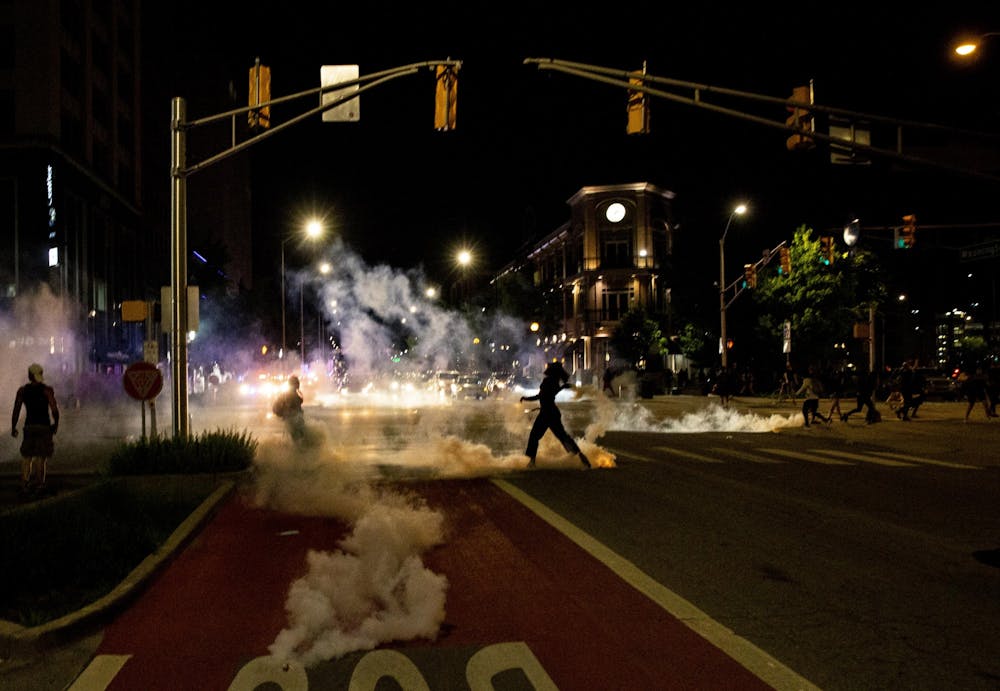Recently, there have been nationwide protests against police brutality, prompted by the murders of George Floyd, Ahmaud Arbery and Breonna Taylor. Many protests, such as the one in Indianapolis, were fueled by local instances of police violence in addition to the nationally famous cases.
Even nonviolent protests have been dispersed by police using tear gas, a choice that often doesn’t get enough scrutiny. Tear gas is a chemical weapon that is banned for use in warfare under international treaties. Over the course of its hundred years of existence, it has been responsible for at least hundreds of deaths. Yet it is legal and often praised as a harmless, or at least non-lethal, form of “riot control” when it is used against civilians.
Tear gas canisters spray a powder designed to cause pain into the air. When the powder comes into contact with human beings, it causes intense pain in the eyes, lungs and skin. The body tries to expel the chemical by coughing, crying and sometimes by vomiting.
Death, internal and external chemical burns and blindness are among the worst effects of tear gas. These are more likely to occur in children, the elderly, those with respiratory conditions and in enclosed spaces, all of whom are also at a higher risk of severe illness from COVID-19. Tear gas also commonly causes panic and is therefore also responsible for countless stampede-related injuries.
There is no global tear gas study or authority, but many individual medical associations have come out against its use. The Himsworth Inquiry, which was commissioned to study the effects of tear gas, treats it as a drug and defines a dosage at which it becomes toxic.
This assumes that police can control dosage in a real-life protest setting, which is nearly impossible. The defined dosage also does not take into account that the actual lethal dosage varies by individual and demographic factors.
How did a chemical like this, which the international community regards as inappropriately cruel for warfare, end up deemed acceptable for use in our communities? The book “Tear Gas” by Anna Feigenbaum traces the history of its development for battlefield use and its subsequent use against, and testing on, civilians.
Tear gas has been used throughout its history to make brutal repression look less brutal. But as Feigenbaum notes, “Today, companies claim to manufacture safer and safer forms of tear gas and less lethal weapons. But what does it really mean to improve on the safety of a device designed to cause harm? Is it truly an accident when a product developed to shoot people in the face is used to shoot people in the face?”
Around the world for the entire history of tear gas, it is more commonly used against oppressed or marginalized communities. Colonized peoples in the mid-20th century, protestors in Chile and Hong Kong last fall and Black Lives Matter and other protesters in the U.S. today have all had it used against them.
Especially in the midst of COVID-19, the difference in the treatment of white protesters and black protesters is clearer than it has been in years. White protesters can strap guns to their bodies and scream in the faces of police officers because they want the economy to reopen. Black protesters and their allies experience far more police escalation, even when behaving more civilly than the majority-white lockdown protesters.
The police are supposed to serve and protect. But the police and the legal system take every opportunity to transfer the risk of harm from law enforcement to the communities they are supposed to be protecting, from lax requirements for the legal use of lethal force to unwillingness or inability to prosecute the police to militarization in general.
If your friends were tear gassed in Indianapolis or any other city this weekend, they shouldn’t have been because the police shouldn’t have had tear gas in the first place. Let’s stop calling tear gas riot control and start calling it what it is: a chemical weapon, too inhumane even for warfare.
Kaitlyn Radde (she/her) is a rising junior studying political science. She plans to pursue a career in public interest law.






